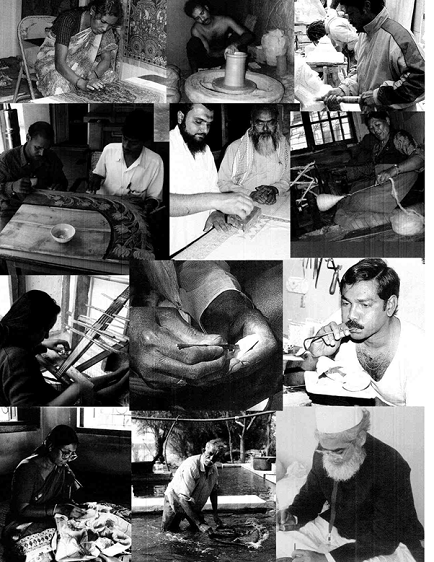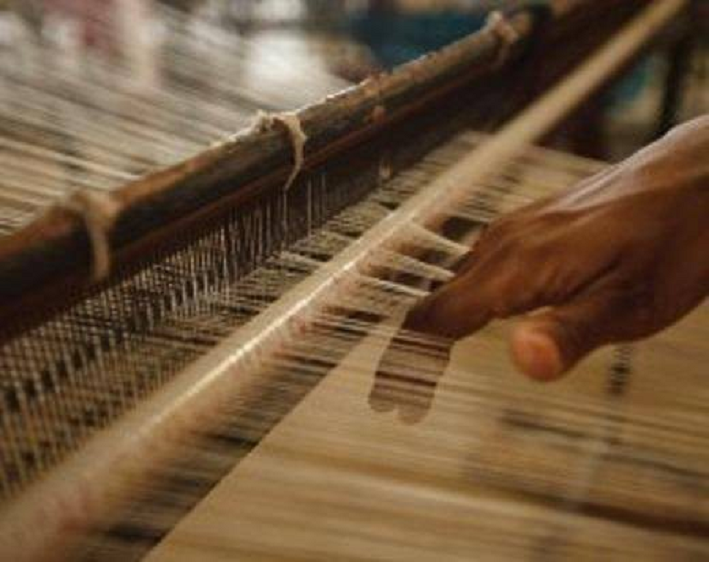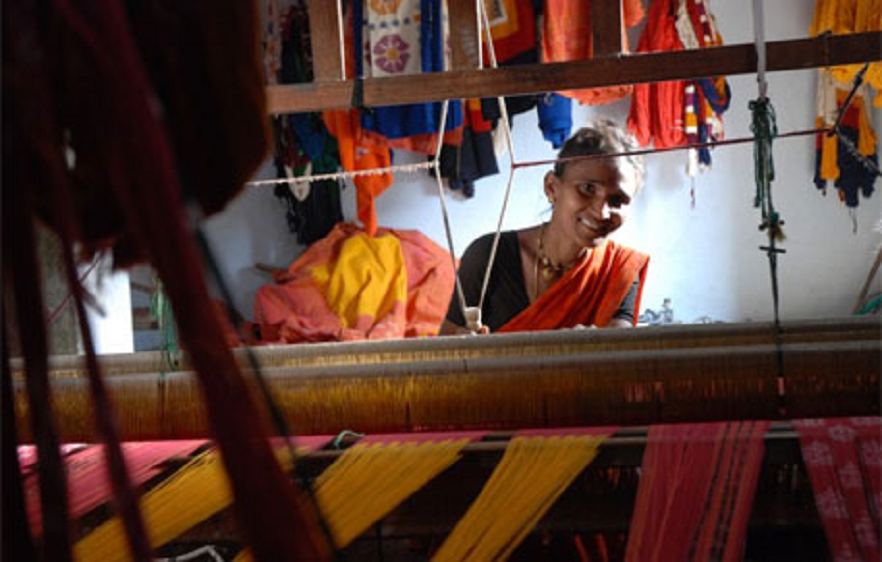 Image courtesy Crafts Council of India
Image courtesy Crafts Council of India
Background: A crisis in the making
The dichotomies of India’s craft experience reflect the centrality of hand production to the freedom struggle under Mahatma Gandhi’s leadership; bold experiments in craft development as part of national planning once India was free; and contrasting notions today of what should represent modernity and progress. Kamaladevi Chattopadhyay pioneered a range of institutions and approaches intended to empower artisans, and to secure a lasting position for craft in India’s culture and economy. Her efforts, and those of craft masters and other leaders, registered many achievements, as Indian crafts swept the country and the globe, demonstrating an ability to evolve and change with new times and new challenges. A craft renaissance was achieved over many hurdles and India’s craft leadership became unquestioned. Yet in more recent times there has been a distinct retreat in understanding and support. Suddenly, the artisan and her culture and skills have been interpreted as representing a primitive past that is out of step with ambitions of global power and influence. New attitudes were revealed in the term ‘sunset industry’ that began to be applied to the craft sector. A sense of crisis now threatens the legacy of India’s craft pioneers and the achievements of another generation of activists. Meanwhile, industrially advanced societies are striving to recover their own craft heritage as a source of creativity indispensable to contemporary need. New approaches in the understanding of development also suggest the incredible value of India’s craft advantage. What is now at stake, and where can we go from here?
A few years back, the Government of India mooted a plan to assist handloom weavers by attaching a small electric motor to their looms. Official worthies further proposed an amendment to the definition of handloom fabric, a move that would be to the great advantage of the dominating power-loom sector. The logic of the motor was to increase productivity and therefore the earnings of deprived weavers — estimated by some at 13 million — competing against power-looms, mills and imports. No questions seemed to have been asked as to why these millions of weavers were still deprived despite global demand for their production, decades after Kamaladevi Chattopadhyay had helped establish institutions and systems that were meant to empower artisans and to sustain their crafts. No questions seemed to have been asked about the logic of converting handlooms into power-looms, removing at one stroke the quality of the hand that distinguishes handloom fabric from power-loom and mill alternatives and providing the handloom product with its global USP. No questions seemed to have been asked about what weavers might think of this extraordinary strategy to serve them by destroying their craft advantage, nor of where the power would come from to get those motors moving. For decades, weavers have been awaiting functioning light-bulbs that could illuminate their cramped workplaces. No questions seemed to have been asked about what clients of handloom production all over the world might think of the motorised fabric that would now be offered to them, devoid of that handmade quality that created demand. This incredibly foolish or diabolically wicked plan — the choice depends on one’s faith in humankind — may well have gone through. Fortunately, it did not. The credit for this goes to one vigilant soul in the now defunct Planning Commission — who happened to notice that this project defied both Twelfth Plan allocations as well as the definition of handlooms on which Plan allocations had been made. Her vigilance was supported by weavers and craft activists around the country. A nationwide movement followed to protect India’s great handloom advantage from an official threat that compounded the harsh competition from mass production. That abhiyan is still ongoing, with the need now to deal with a new political environment committed to what we must welcome as ‘market forces’.
The sunset syndrome
The recent crisis in the handloom sector demands understanding, not merely because millions of Indian lives are at stake. More critical is the crisis of values and of mindsets that is the root cause. How and when did pride and confidence in India’s artisans transform into apathy and contempt, their skills dismissed as obsolescent and their culture as defeated? A nation that lacks basic data for its second largest industry is clearly not committed to it. If even economic potential is ignored or regarded as a threat to modernity and power, what chance is there for those other craft values that are cultural, social, environmental and spiritual? Has an India emerged that no longer values the need for different knowledge systems to coexist and enrich one another? The only constant over these years has been showcasing of crafts and artisans on festive occasions, to the accompaniment of mantras extolling our ancient heritage and cultural superiority. Walking the craft talk has been another matter altogether. While Kamaladevi’s generation epitomised India’s capacity for synthesis, diversity and tolerance, today’s schizophrenia mixes mantras of an ancient past with cultural intolerance masquerading as pride, and garnished with Singapore/Silicon dreams. Crafts and artisans are caught in a bind — simultaneously needed for cultural window-dressing and dismissed as irrelevant relics. The handloom crisis is a symptom of this malaise.
The concept of cultural industries
Almost at the same moment that influential Indian planners were declaring craft a sunset activity, the European Union could be heard proclaiming that the ‘future is handmade’. So what would Kamaladeviji, Pupul Jayakar, LC Jain and so many other stalwarts of the past make of these contradictions? How would they respond to the contrasting message given out from the EU of all places? Would they ask bemused whether Europe is planning to abandon the machine and revert to its pre-industrial artisanal past? And if that is unlikely, then how indeed is the global future to be handmade? The European response would have resonated with their own deep understanding of craft cultures within the larger human consciousness. The call from Europe is a reminder that creativity and innovation are the only human capacities available to any economy if it is to survive and to flourish in today’s globalised economy. This creative ability to respond to change is embedded in cultures that harmonise the hand, eye and mind. Destroy these deeply-rooted capacities, and not just crafts but all national creativity is endangered. Japan, Taiwan and South Korea have long attributed their success in electronic, computer and automotive industries to craft attitudes embedded in their national psyche. One example is Kanazawa in Japan, now registered as a City of Crafts in recognition of “The spirit of artistic production that made possible Kanazawa’s own industrial revolution and made it the home of top engineering companies”. Switzerland, Scandinavia, Germany and Italy recognize their craft heritage in the success of precision and engineering industries as well as in design leadership. Thailand and China are making major investments in craft strategies, while the USA and the UK are rediscovering the potential of their craft sectors. There is today a growing literature of cultural economics as a discipline which appreciates that cultural goods and services actually add much more value than what is realized in the market. We Indians have neglected this link despite brilliant demonstrations that range from Dilli Haat and the Festivals of India to Titan watches and the machine tool industry of Surat. In 2005 India was host to a world symposium that culminated in the Jodhpur Consensus on Cultural Industries which recognized these industries “as a source of capital assets for economic, social and cultural development” and as “a vital source for the cultural identities of communities and individuals which lead to further creativity and human development… What cultural industries have in common is that they create content, use, creativity, skill and in some cases intellectual property, to produce goods and services with social and cultural meaning.”
The reminder that artisans “produce goods and services with social and cultural meaning” addresses those for whom the term ‘cultural industries’ can be disquieting, with possible overtones of selling out. What protection is there in the marketplace for the culture of the spirit through which craft traditions travelled through the centuries, not as mere products but as rich expressions of the mind engaged in service? In Kamaladevi’s words, it is the artisan’s tender care of the substance of everyday life and of nature’s own rich store house that adds a finer dimension to our being. Is there place in the market for such caring?
Perhaps a first need is for a respectful acceptance of the marketplace as a space familiar to Indian artisans throughout history, and the only space that can deliver meaningful livelihoods. Today’s challenge is to empower the artisan to negotiate effectively with market forces, rather than to fear them. Gandhi’s respect for the customer, the ultimate user of the handmade, was legendary. His understanding and ability to use the market enabled the swadeshi movement and made possible the handloom revolution. To my generation, Cottage Industries, Contemporary Arts & Crafts, Sohan, Handloom House, Sasha, landmark Khadi Bhavans and the Fabindia of John Bissell were among the craft experiences that moulded us while also delivering to artisans the possibility of dignity and hope. It was the changing market in India and overseas that forged partnerships between craftspersons and designers to develop an idiom of Indian craft that could responds to contemporary need. The challenge therefore is not one of market threat but rather fostering the capacity of artisans to negotiate effectively with the market, and effectively protect their own interests within a situation of constant change and unrelenting competition.
Building demand for hand quality
To do this requires building consumer awareness of craft quality and thus generating a demand for the quality that only the hand can deliver to markets at home and around the world. Demand requires awareness. Awareness begins with education — education that can sensitise the Indian child and tomorrow’s consumer to her craft heritage and its relevance to her own well-being. An important opportunity is now available through the craft curriculum offered to Indian schools through the NCERT (National Council of Educational Research and Training). The curriculum reflects the though and effort of Professor Krishna Kumar. He shared his perspective from this podium through the second Kamaladevi Memorial Lecture “Hastkalayein aur Shiksha” in February 2011. I would urge CCRT (Centre for Cultural Resources and Training) to translate Professor Kumar’s lecture not only into English but into every language so that his insights can reach and engage the entire sector.
India’s artisans themselves represent a great educational advantage. They are unmatched in their ability to communicate through their hands an understanding of materials, technology, function and aesthetics. Yet our master artisans are excluded as educators because they lack the formal degrees and certificates of the so-called qualified. This must change because without another generation of Indians who understand the value of the handmade through direct encounters with the craft culture and wisdom, respect for artisans and demand for hand-made quality may be impossible to ensure. Education and awareness cannot be restricted to formal and informal channels of education. The father-to-son and mother-to-daughter channels to which crafts have passed through generations represent not just vocational education and training but lessons in aesthetics and in the human spirit that no school can match. Today these traditional channels can be challenged by the need to distinguish between craft paramparas on the one hand and the issues of caste barriers and of child labour on the other. What education must offer to the children of artisans is the option of a hereditary profession by choice and not by compulsion. For other children, it should be the option to join and to participate in a shared legacy of heritage. This is not an impractical dream. It is happening in Maheshwar, Kutch and elsewhere.
Transformed landscapes, tectonic shifts
Many of us who have been trying to manage the challenges of traditions in transition tend to ascribe failures to our own incapacities, or to the poor framing and execution of national policies, to bureaucratic insensitivity, or to the absence of any clear strategy to raise demand for handmade quality. Perhaps we need also to go beyond these symptoms of crisis to an even deeper understanding of tectonic shifts taking place on our ground. These shifts include those which I have described of attitude and perception. The aspirations of artisans and their clients have also changed from acceptance of past identities to those associated with new concepts of progress and modernity. There are also huge market transformations, transitions demanded by urbanisation, the impact of political forces, and the colossal influence of environmental change.
Perhaps the most obvious shift has been that of a transformed market. The struggle for livelihoods is bereft of pre-Independence barter systems and the patronage of temple, mosque and palace. Systems of support from Central and State authorities made major contributions to the sector, keeping it alive within a protected economy. In the so-called free market of liberalised globalisation, past schemes have become increasingly irrelevant. The self-sufficient village of centuries, the gram rajya of Gandhiji’s dream, is now a space invaded by urban dreams and demands for urban services. The user of what the village artisan makes is now a distant, most often unknown entity located in the cities of India and the world. To understand her and to influence her choices requires a range of ‘middleman’ functions: access to market knowledge, to design and technology, to finance and to channels of distribution. Each function can be exploitive or supportive. Which it will be now depends primarily on the artisan’s capacity to negotiate and to influence the market chain with its demands of timely delivery, quality control, merchandising, trade regimes and, above all, of competition from alternatives. The need now is for building greater management capacities and services at the grassroots, for entrepreneurship capacities that can negotiate unlimited market opportunities at home and overseas, as well as the range of market threats. Self-reliant entrepreneurship rooted in inherited wisdom and combined with current knowledge is perhaps the most essential prerequisite for sustainable livelihoods from handcraft. The most essential, but certainly not the only prerequisite.
Rural crafts or a rural myth? The challenge of sacred spaces
Access is another. Access to markets and to services that have failed to reach the village doorstep, forcing the movement of artisans away from villages into town and cities. Many of us are still obsessed with the myth of preserving a rural culture —- ‘cottage’ industries, handmade in kutirs. The truth is that many of our craft traditions have moved into urban slums and pavements. Every Indian city reveals this fact, with artisans working and selling at whatever corner of space they can find. Hovels, not kutirs, crowded with artisans in search of markets, materials and finance. This trend will accelerate as India evolves as an urban society, a transformation to which the present administration is wholly committed. The implications are huge for re-defining or re-discovering the cultural integrity of Indian craft.
The shift is not just physical. It is a movement of the mind.
 Image courtesy Indian Ministry of Textiles
Image courtesy Indian Ministry of Textiles
Earth Mother and her artisan children
The shift is not just cultural. The natural environment is degrading at a pace that threatens not just the craft inspiration but its materials as well. Crafts have depended on nature for so many resources, elements and benchmarks of excellence: woods, grasses, fibres, stone, natural colours, earth and water, not to speak of design inspiration. Yet today each of these essential elements is threatened and often far removed from direct experience. Resources that once were free or accessible within habitats have disappeared due to environmental degradation, natural disasters and greed. How can motifs drawn from nature retain their freshness if new generations are denied the inspiration of having lived with nature and having absorbed the inspiration of changing seasons? And what of climate change that today threatens us with intensifying disasters of the kind Jammu & Kashmir have just witnessed, that Assam and Uttarakhand have endured, and that have brought such havoc to coastal Andhra Pradesh and Tamil Nadu — everywhere destroying the materials, tools, and stocks of artisans? If nature’s integrity is a sine qua none of craft inspiration, does this require that craft activists now partner efforts at protecting the earth? Must we help redress the imbalance between development and greed with a culture of replenishment and concern for tomorrow? This is the message of Dastkar’s Green Bazaars.
Craft harbingers of justice
Another shift is political and social, recalling the million mutinies of our land. A map of Indian tensions would include the Naxal corridor, Kashmir and north eastern states. These locations are also our richest craft resources. Does this fact tell us something about those attitudes of sunset and neglect, and of the potential of Indian crafts as a huge social and political safety net? Can craft cultures flourish amidst violence and injustice? Consider the reality that the vast majority of India’s artisans comprise those marginalised by society: scheduled castes and scheduled tribes, minorities, women, and citizens of some of the most disturbed areas of the land. Can we expect rich craft contributions from those deprived of rights others take for granted and living with neglect and violence? Is our craft culture then a valid argument to be advanced in the cause of peace and justice? If so, what demands does that make on us craft activists? Does this mean that the struggle for human dignity and for human rights is an inescapable aspect of our movement toward sustainable crafts? Does this demand that we forge new partnerships with those who struggle for justice and for peace? Do we have the stamina now to be rights activists as well? Do we, should we, have a choice?
The development agenda: a craft opportunity
Such a range of challenges may seem an impossible agenda for most of us who are still led by passions of the heart, not by strategies of the head. Applications of social sciences, politics and management are still unfamiliar to most of our work territories. Indeed, they often appear as threats to the cultural and spiritual qualities we hold dear. Yet the sector’s greatest strength may well be that its impact and influence are cross-cutting, intersecting with so many national and global priorities. Perhaps as no other industry, craft is deeply involved with the most fundamental development agendas of our time: managing threats to the environment, promoting justice and equity and peace by bringing the deprived into the centre of concern, empowering women through recognition of their craft roles and contributions, offering identity and confidence in an era threatened by globalised uniformity, providing sustainable livelihoods to households and communities in their own locations through the use of local resources, protecting them from the miseries of migration, and leaving a light carbon footprint to address the threat of climate change. In other words, an industry that probably reflects as no other, both the issues as well as the opportunities for sustainable development. The opportunity of craft is to bring back what Kapila Vatsyayan has described as “The experience of the whole, the total, in its multi-layered inter-webbing and inter-relatedness”. Thus, a cutting-edge industry which represents in itself a development agenda, a movement that is social, cultural, political and environmental, and one that carries within it the seeds of spiritual awakening.
This is an abridged version of the 5th Kamaladevi Chattopadhyay Memorial Lecture delivered on October 29, 2014 at the Centre for Cultural Resources and Training, New Delhi. Read the full text here on the Indian Cultural Forum.



